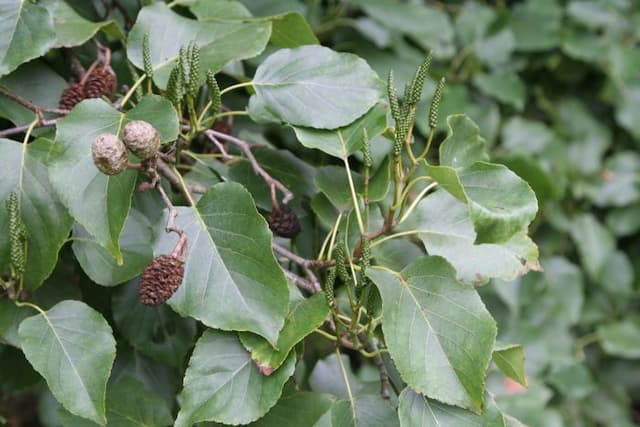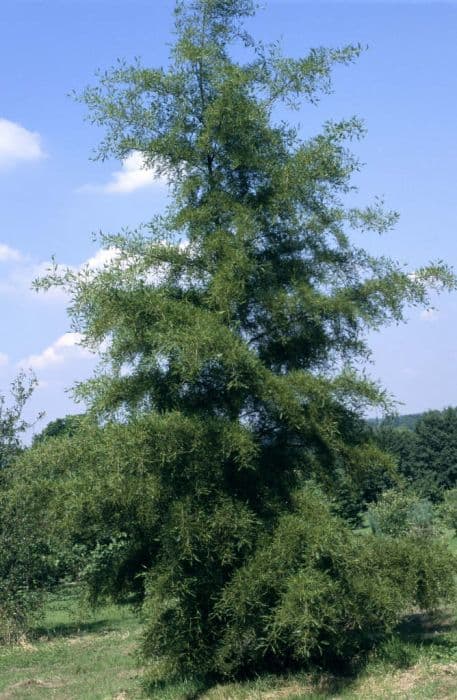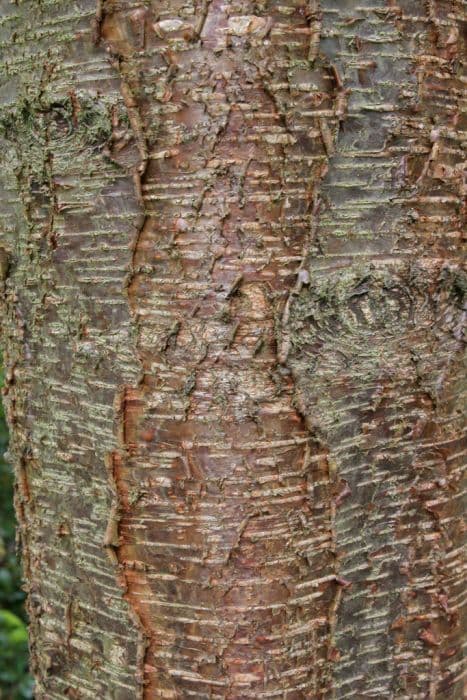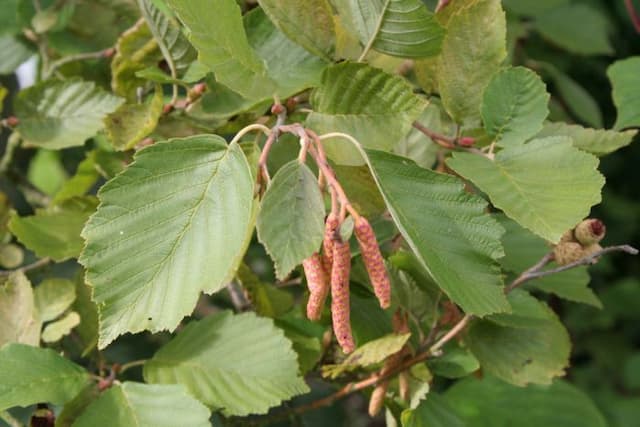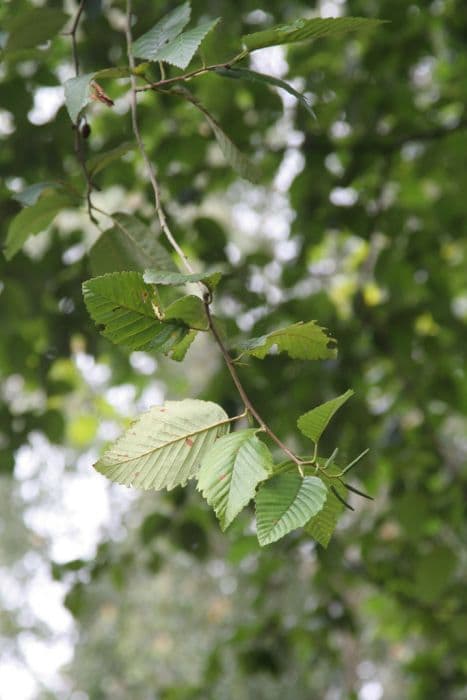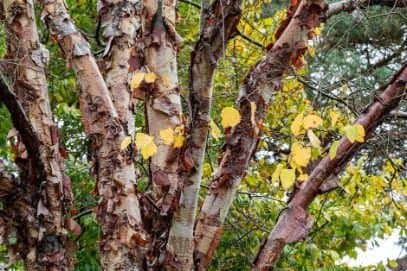Turkish Hazel Corylus colurna

ABOUT
The plant commonly known as Turkish hazel has a notable and distinguishable appearance. The trunk of this tree is characterized by its thick, corky bark that offers a unique texture, and the branches grow in a regular, symmetrical pattern which gives the plant a robust and well-defined silhouette. Turkish hazel is adorned with large, broadly rounded leaves that have a rich green hue during the growing season. These leaves usually have a fuzzy texture and a somewhat heart-shaped base, with a pointed tip and a double-serrated edge, giving a lush and dense canopy. In late winter to early spring, before the leaves emerge, the tree produces catkins, which are long, hanging clusters of flowers with the male catkins being more prominent and visible. Following the flowering period, the Turkish hazel bears fruit that is encased in a husk, a feature particularly notable in late summer to autumn when the fruits mature. This husk looks like a leafy capsule, from which a hard-shelled nut, the actual hazelnut, emerges. The overall appearance of the Turkish hazel is one of strength and sturdiness, coupled with the interesting textures of bark and nut husks, and the seasonal interest provided by its flowers and foliage.
About this plant
 Names
NamesFamily
Betulaceae
Synonyms
Turkish Hazel, Turkish Filbert, Constantinople Hazel, Colurna Nut
Common names
Corylus colurna var. lacera, Corylus colurna var. glandulifera, Corylus colurna var. glabra
 Toxicity
ToxicityTo humans
The plant Corylus colurna, commonly known as the Turkish hazel, is not typically regarded as poisonous to humans. In general, the nuts of this plant are edible when cooked and not known to cause harm. However, as with many plants, some individuals may experience allergic reactions or digestive upset if parts of the plant are consumed inappropriately or if an individual has a specific sensitivity. But overall, there are no well-documented toxic effects associated with the ingestion of Turkish hazel by humans under normal circumstances.
To pets
The Turkish hazel, scientifically known as Corylus colurna, does not have a widespread reputation for being toxic to pets. Its nuts and other parts are not commonly listed as poisonous to household animals such as dogs and cats. That being said, individual pets might have allergies or sensitivities to this plant, and consumption of non-food items can always carry a risk of choking or causing an intestinal blockage, especially if large pieces are ingested. As a precaution, it is generally advisable to prevent pets from ingesting plant material to avoid any potential digestive issues.
 Characteristics
CharacteristicsLife cycle
Perennials
Foliage type
Deciduous
Color of leaves
Green
Flower color
Yellow
Height
40-60 feet (12-18 meters)
Spread
15-20 feet (4.5-6 meters)
Plant type
Tree
Hardiness zones
5
Native area
Southeastern Europe to Western Asia
Benefits
 General Benefits
General Benefits- Aesthetic appeal: The Turkish hazel offers visual interest with its attractive foliage, which changes color with the seasons.
- Shade provider: As a tall tree, it can offer significant shade, making it a valuable addition to parks and large gardens.
- Erosion control: The deep root system of the Turkish hazel can help to stabilize soil and prevent erosion.
- Habitat for wildlife: It provides food and shelter for various species of birds and small mammals, which feed on its nuts.
- Durable wood: The wood of the Turkish hazel is hard and dense, making it useful for furniture, tool handles, and other wood products.
- Edible nuts: While not as commonly harvested as other species, the Turkish hazel produces nuts that are edible.
- Low maintenance: Once established, it is relatively drought-tolerant and does not require excessive care.
 Medical Properties
Medical Properties- This plant is not used for medical purposes.
 Air-purifying Qualities
Air-purifying QualitiesThis plant is not specifically known for air purifying qualities.
 Other Uses
Other Uses- Corylus colurna, commonly known as Turkish hazel, wood can be used for cabinets and wood-turning due to its toughness and the attractive pattern it creates when polished.
- The tree's dense, rot-resistant wood is suitable for outdoor construction, such as in pergolas and decking, providing durability and a rustic aesthetic.
- Fine veneers for luxury automobile interiors can occasionally be produced from the wood of the Turkish hazel, given its decorative grain.
- Due to its resistance to warping, Turkish hazel can be utilized in the production of longbows and other traditional archery equipment.
- The tree's catkins provide an early source of pollen for bees and other pollinators, which is crucial when other food sources are scarce in early spring.
- Turkish hazel nuts are a source of food for wildlife, such as birds and small mammals, sustaining biodiversity within its ecosystem.
- The tree is sometimes planted as a rootstock for cultivating different, less hardy hazelnut cultivars due to its robust root system and adaptability to various soil types.
- In urban landscaping, Turkish hazel is used for its ability to tolerate pollution and compacted soils, making it an attractive choice for street trees and public parks.
- The large, textured leaves of the Corylus colurna can be used as a natural mulch or composting material that enriches soil as they decompose.
- Because of its distinct branching pattern, Turkish hazel is used to create living fences or privacy screens in landscaping projects.
Interesting Facts
 Feng Shui
Feng ShuiThe Turkish hazel is not used in Feng Shui practice.
 Zodiac Sign Compitability
Zodiac Sign CompitabilityThe Turkish hazel is not used in astrology practice.
 Plant Symbolism
Plant Symbolism- Protection: Corylus colurna, commonly known as the Turkish hazel, has been associated with protection due to its sturdy nature and the belief that hazel wood wards off evil.
- Wisdom: The hazel tree has often been linked to wisdom and knowledge, possibly because of its historical association with ancient wisdom through divination rods and staffs made from hazel wood.
- Reconciliation: In some traditions, the hazel tree represents reconciliation, as hazel branches have been historically used to craft 'wishing rods' that were believed to help resolve conflicts and make peace.
 Water
WaterThe Turkish hazel tree should be watered regularly during its first growing season to help establish a robust root system. Afterward, it should be watered deeply every 2 to 3 weeks, depending on the weather conditions. The soil should be kept moist but not waterlogged. Approximately 10 to 15 gallons per watering should suffice for young trees, adjusting as the tree matures and depending on rainfall. It is vital to avoid overwatering as this can lead to root rot.
 Light
LightTurkish hazel thrives in full sun to partial shade. It is best to plant it in a location where it receives at least 4 hours of direct sunlight each day. The tree can tolerate some shade but will have more vigorous growth and better nut production in a sunnier spot. Avoid deep shade as it can lead to reduced vigor and sparse foliage.
 Temperature
TemperatureTurkish hazel is quite tolerant of a range of temperatures and can withstand winter temperatures down to around -20°F. It thrives best in a climate where temperatures range from 35°F to 85°F. It's important to plant it in a location where the temperature does not consistently drop below its minimum tolerance level to avoid freezing damage.
 Pruning
PruningPruning the Turkish hazel is essential to maintain its shape, remove any dead or diseased branches, and promote better air circulation. Prune the tree during its dormant season in late winter or early spring before new growth starts. Pruning should be done annually to maintain the desired size and remove any suckers that may form at the base of the tree.
 Cleaning
CleaningAs needed
 Soil
SoilTurkish hazel thrives in well-drained, fertile soil with a pH range of 6.0 to 7.5. The best soil mix is a blend of loam, compost, and sand to ensure adequate drainage and fertility.
 Repotting
RepottingTurkish hazels, being large trees, are not commonly repotted. They are typically planted once in an appropriate location where they can grow undisturbed.
 Humidity & Misting
Humidity & MistingTurkish hazel trees are tolerant of a wide range of humidity levels and do not require specific humidity conditions for growth.
 Suitable locations
Suitable locationsIndoor
Growing Turkish hazel indoors is not practical due to its large size.
Outdoor
Plant Turkish hazel in full sun, well-draining soil, and space for growth.
Hardiness zone
5-8 USDA
 Life cycle
Life cycleThe Turkish hazel (Corylus colurna) begins its life cycle as a seed, which upon suitable conditions of moisture and temperature germinates underground and gives rise to a seedling. As the seedling grows, it develops a tap root and leafy shoots that emerge above the soil, entering the juvenile phase where growth is primarily vegetative. The young tree gradually matures and enters the reproductive stage, which is marked by the development of male catkins and female flowers that are wind-pollinated. Following successful pollination, the flowers develop into nuts enveloped in a hard shell, enclosed by a husk. These nuts fall to the ground and can be dispersed by animals or gravity, becoming a potential new generation if they find a suitable place to germinate. Over many years, the tree can grow to a considerable height and girth, and under favorable conditions, a single Turkish hazel can produce nuts for several decades before reaching the end of its life cycle.
 Propogation
PropogationPropogation time
Spring
Propogation: Turkish hazel, commonly known as Corylus colurna, is primarily propagated by seed. The best time to collect seeds is in the autumn when they are fully ripe. To propagate Turkish hazel by seed, you should first stratify the seeds, which involves exposing them to a period of cold temperatures to break their dormancy. This can be done by mixing the seeds with moist sand and storing them in a refrigerator for approximately two to three months. Following stratification, the seeds are sown in seedbeds or pots at a depth of about 1 to 2 inches (2.5 to 5 centimeters). It is important to keep the soil moist but not waterlogged to foster germination. Seedlings usually emerge in the spring and can be transplanted to their permanent location once they have reached a suitable size and have developed a strong root system.
